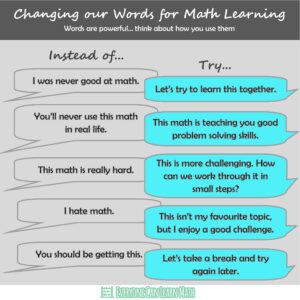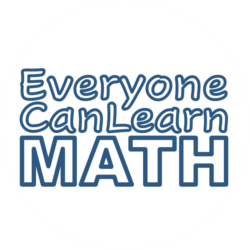This blog post was originally written for the Shelley Gray Teaching Blog. Read the original blog post here.
Growth mindset has become very popular in education and is, in a way, a bit of a buzz term. However, the benefits of applying growth mindset strategies in the math classroom have been visible among most of my students in my secondary mathematics classroom. I am a strong advocate for shifting our teaching from fixed mindset approaches to ones that incorporate a growth mindset. Below are five ways teachers can build a positive math mindset into their classrooms. Some of these ideas come directly from Dr. Jo Boaler’s Mathematical Mindsets and others are my own experiences having implemented an intentional growth mindset classroom since 2016.
***
1. Pay Attention to your Vocabulary
The words we choose when speaking to students is one of the most powerful tools we have at our disposal for developing a growth mindset. Changing our vocabulary from fixed mindset language to growth mindset language has been proven to help our students believe they can learn math, which in turn increases their willingness to try something new.
We often talk about the influence parents have on their children when it comes to their language framed around math. However, it is just as important for us, as educators, to also be aware of the words we use around children of all ages. Words can either motivate or discourage a child from reaching their potential in a classroom.
The image below offers some substitutions for common negative language used in relation to math. We can use these examples ourselves and we can offer them as suggestions for parents and students when they are encountering challenges when learning math.

2. Believe in your Students’ Abilities
Our students know when we believe in their potential to be successful. It is important to tell our students frequently and explicitly that we think they are good mathematicians. Focus on praising the effort and the process rather than the final result and your students will begin to believe in themselves as much as we do.
In Mathematical Mindsets, Boaler references a study done in high school English classes where hundreds of students wrote essays and received feedback. Half the students were given an extra sentence at the end of their feedback, “I am giving you this feedback because I believe in you.” A year later, the students who were given the extra sentence were still performing at higher levels than those who had not.
Students can sense when we want them to do well, but let’s take it a step further and make it clear that we believe in them and know they can learn math.
3. Embrace Mistakes as Growth
Creating an atmosphere in our classrooms that allows students to take risks ensures that students will start problems without the fear of making mistakes. There is a misconception among students that they should just “get” math the first time they are taught it and when they make a mistake, they feel discouraged.
When we think of learning anything new in our lives, we very rarely know how to do something the first time we try without making any mistakes. An example that always comes to mind is when my daughter was learning to skip rope. She tried over and over again, at first only skipping once or twice over the rope before it got tangled in her feet. However, she persisted. She set small goals for herself. First, she tried to get three jumps in a row, then five, and so on. Can we help our students apply this same mindset to learning mathematics?
We don’t need to solve a problem on the first try, but we need to be willing to embrace the mistakes and learn from them.
In a recent session at the “Virtual Math Summit” by Building Math Minds, Pamela Seda offered this list for embracing mistakes in the math classroom:
Mistakes are
- Expected
- Respected
- Inspected
- Corrected
The other important part of embracing mistakes is to model a growth mindset ourselves as educators. We cannot expect our students to be open to learning if we aren’t setting the same example.
4. Offer Multiple Opportunities for Assessment
In keeping with the idea that mistakes are to be embraced when learning mathematics, we need our students to know that if they make mistakes, they will have more opportunities to show that they have corrected their mistakes and learned from them. Therefore, it is important to offer our students multiple chances to show their learning. This is why re-assessments play a necessary role in the growth mindset classroom.
I feel very strongly that students should be allowed re-assessments, no matter the grade level because the goal is to learn a concept, not to have learned it the first time they are assessed. In my experience, re-assessments, especially at the secondary level, are met with a lot of resistance. I think this is because we have become very grade focused. If we refocus – both ourselves and our students – on the learning process, instead of the outcome, we can place more value on learning from our mistakes, thus opening the door to re-assessing when students have had a chance to fix and learn from their previous errors.
5. Listen to your Students’ Feelings
Although we want our students to have a growth mindset when learning math instead of thinking they are just “bad at math,” it is still important to acknowledge students’ feelings toward math. Math anxiety is a real thing for many people, so we don’t want to dismiss those feelings.
On the first day of the semester, I ask my new students to anonymously answer the question “How do you feel about math?” on a piece of paper. When everyone is finished, we crumple up our papers and toss them across the classroom (you may know this as a “Snowball” activity). Each student picks up a random paper and opens it up. We then take turns reading the answers aloud, knowing that all the papers have been randomized. Not surprisingly, in grades 9 and 10, I see mostly negative feelings associated with mathematics. We talk about how we will work toward improving our math abilities during the semester and students feel empowered to know that their feelings have been acknowledged and are being considered in the structure of our classroom. I usually save all the responses until the last day of class and we do the same activity all over again. It is amazing to hear changes in math attitudes, even if only slight.
By acknowledging our students’ negative emotions around math, we show them that their feelings are valid and important. We also have a starting point toward changing those math attitudes.
***
Implementing explicit growth mindset strategies in my classroom over the past four years has drastically changed my students’ attitudes toward learning math, leaving them with increased confidence and more willingness to learn. I think this should be the goal of the mathematics classroom – not just to produce high grades – but to encourage students to want to learn and improve themselves.
Keep spreading the math love <3
![]()
